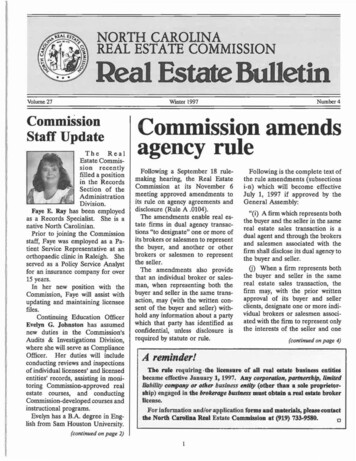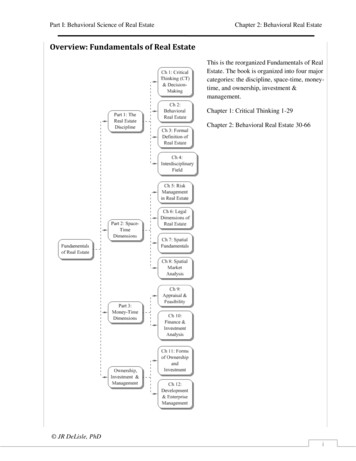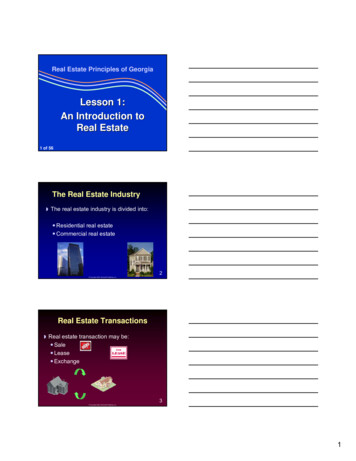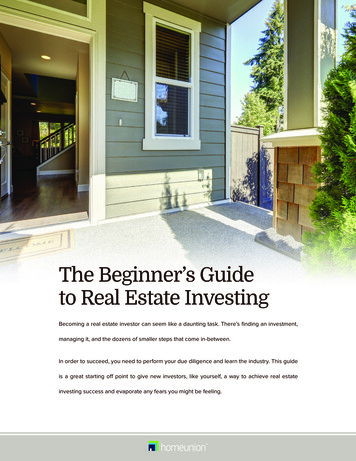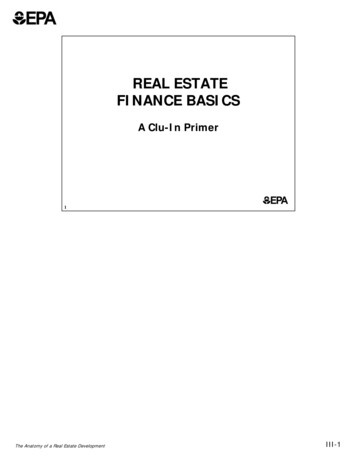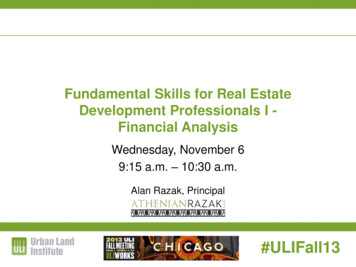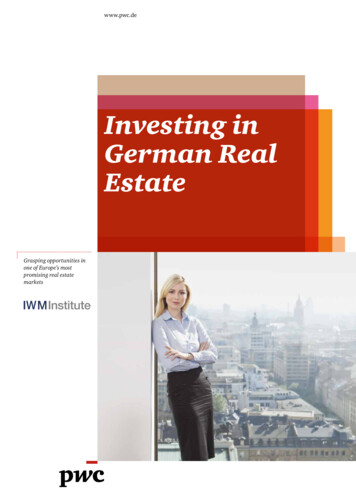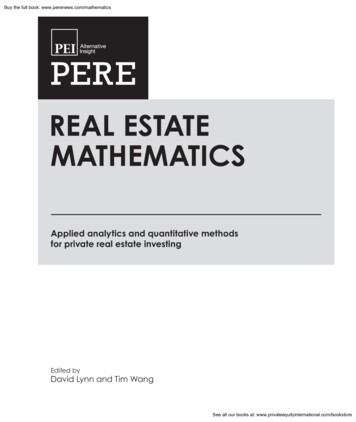
Transcription
Buy the full book: www.perenews.com/mathematicsREAL ESTATEMATHEMATICSApplied analytics and quantitative methodsfor private real estate investingEdited byDavid Lynn and Tim WangSee all our books at: www.privateequityinternational.com/bookstore
Buy the full book: www.perenews.com/mathematicsContentsFigures and tablesviiAbout the editorsxiiiIntroduction and acknowledgementsxvBy David Lynn, Clarion PartnersSECTION I: FUNDAMENTALS1234Private real estate allocations in multi-asset investment portfolios3By Greg MacKinnon, Pension Real Estate AssociationIntroductionThe standard arguments for real estateMean-variance optimisationPortfolio theory issuesAn alternative allocation paradigm: liability-driven investingConclusion349111314Forecasting real estate returns17By Timothy BellmanIntroductionWhy forecast real estate performance?What to forecast?How to forecast?Qualitative approachesForecasting in practice171818202426Real estate investment capital structure31By Hugh Kelly, Real Estate EconomicsIntroductionCapital structure at the industry levelIndustry structure reflects individual investment characteristicsLeverage generates risk and opportunity for the equity investor – and the lenderWhy not ‘borrow to the max’?What is the lender paid for?The premium for taking real estate equity investment riskThe mezzanineHow the mezzanine preferred equity solution worksConcluding observation31313233333536373839Contrasting approaches to quantifying risk in real estate investments41By Jon Southard, CBRE Econometric AdvisorsIntroductionScenario approach4141iiiSee all our books at: www.privateequityinternational.com/bookstore
Buy the full book: www.perenews.com/mathematicsContentsStochastic Monte Carlo analysisUsing the standard error of the estimate (SEE)Combinations of the three approachesConclusionAppendix A: Procedure for approximating VaR level of a specific scenario567894344464849Modelling uncertainty: Monte Carlo analysis and the pricing of real estate 51By Randall Zisler and Matthew Zisler, Zisler Capital Associates, LLCThe nature of real estate and recent encounters with riskMonte Carlo analysisBuilding a Monte Carlo modelA sample application of Monte Carlo modellingThe future of real estate risk analysis5152556165Analysing and pricing risk in international real estate markets67By Maurizio Grilli and Richard Barkham, GrosvenorIntroductionHurdle ratesThe risk-return equationThe risk premiumTarget versus expected returnsConclusion676768717475Special considerations in sustainable property financial analysis77By Scott Muldavin, Green Building Finance ConsortiumIntroductionStep 1: Selecting the financial modelStep 2: Evaluating property sustainabilityStep 3: Assessing the costs/benefits of sustainabilityStep 4: Evaluating the financial implications of costs/benefitsStep 5: Determining financial model inputsStep 6: Conducting a risk analysis and presentation (RAP)Sustainability investment performanceConclusion777779798081848587Real estate loans and real estate debt89By Sam Chandan, Chandan EconomicsIntroductionLeverage and the incentive to borrowWhy borrow?When to borrowMortgage descriptors and measures of qualityRegulation of lendingInvesting in distressed loansPolicy intermediation and recovery rates8989909090939496Distressed debt investing97By David Lynn and Tim Wang, Clarion PartnersCommercial real estate debt and its innovationsLoan terms and underwriting standards9798ivSee all our books at: www.privateequityinternational.com/bookstore
Buy the full book: www.perenews.com/mathematicsContentsDebt maturity and refinancing needsDistressed debt investment strategiesConclusion100101107SECTION II: INVESTING1011121314CMBS securitisation and investing111By Josh Younger, JPMorgan Chase & Co.The rise, fall and rebirth of the CMBS marketThe securitisation processOverview of a typical securitisationRisks in CMBS investingImportant differences between legacy CMBS and more recent transactionsConclusion111115115117120121Key considerations in joint-venture projects123By Roy Schneiderman and Dean Altshuler, Bard Consulting LLCIntroductionAllocation of cash flow, waterfalls and incentive feesItems more likely to arise in multi-property or programmatic JVsNon-incentive feesConclusion123123132133134Cash-flow considerations for value-added deals135By Pip White and Nigel Allsopp, MGPAIntroduction to value-added deals: a hybrid approachInvestment strategies: refurbishment, redevelopment and repositioningBusiness planning: a balancing actScenario planning: expect the unexpectedCash-flow analysisConclusionAppendix: Cash-flow analysis at exit135135136137137142144Cross-border investment: Considerations and risks145By Paige Mueller, GIC Real EstateIntroductionWhy invest internationally?Sovereign economic and political market analysisSovereign real estate market analysisUnderwritingPortfolio strategy and riskConclusion145145147151153155156Benchmarking real estate performance157By Kevin Scherer, BlackRockWhy benchmark?Available benchmarksThe mathematicsRisk-adjusted performance measuresPerformance attributionSome concluding thoughts on the future of real estate benchmarking157157160163165172vSee all our books at: www.privateequityinternational.com/bookstore
Buy the full book: www.perenews.com/mathematicsContentsSECTION III: FUND AND PORTFOLIO MANAGEMENT1516171819Principles of real estate appraisal177By Aart Hordijk, ROZ/Tilburg University, and Peter van ArnhemIntroductionAppraisal historyInternational valuation standardsAppraisal conceptsAppraisal methodsChallenges ahead177177177179183189Valuation of income-producing real estate191By Phillip H. Gainey IV, Royal Institute of Chartered SurveyorsIntroductionThe DCF frameworkA DCF model exampleSensitivity to assumptions191192194200Management fee, carried interest and other economic terms ofreal estate funds203By Derek Williams, Russell InvestmentsIntroductionFeesSponsor commitmentTotal expense ratio (TER)Bid-offer spreads and ‘at-NAV’ priced fundsRight of first refusal (ROFR)Conclusion203203207207207208209Mathematical concepts in building a real estate multi-manager portfolio 211By Edward Casal and Tiffany Thomas, Aviva InvestorsIntroductionInvestment process overviewDeveloping a model allocationInvestment analysisPortfolio constructionAsset managementConclusion211211212213222224225Portfolio returns and volatilities through the cycles227By Kenneth Riggs, Real Estate Research CorporationIntroductionIdentifying and understanding business cyclesAnalysing commercial real estate attributes relative to business cyclesQuantifying portfolio risk and return cyclical considerations and conclusionsfor portfolio returnsConclusionAbout PEI227227230234236240viSee all our books at: www.privateequityinternational.com/bookstore
Buy the full book: www.perenews.com/mathematicsFigures and tablesFiguresFigure 1.1:Income dominates as long run source of returns, 1984–2011Figure 1.2:Appraisal versus transaction price-based indices, 1984–2011Figure 1.3:Effect of leverage on volatilityFigure 1.4:Mean-variance optimised allocation for an 8 percent target returnFigure 2.1:Approaches to forecastingFigure 2.2:A conceptual framework for a causal/structural model to forecast real estatereturns using a system of equationsFigure 2.3:The demographic and economic underpinnings of real estate demandFigure 3.1:US real estate capital structure (in billion)Figure 3.2:Leverage ratio increases risk exponentiallyFigure 4.1:Base case and double-dip recession forecast of net operating incomeFigure 4.2:Monte Carlo analysis resultsFigure 4.3:Two percent VaR point within the Monte Carlo distributionFigure 4.4:Distribution around the forecast based on standard errors of the estimateFigure 4.5:Based on Year 2, the appropriate VaR estimate for a double-dip scenario is76 percentFigure 4.6:Use of IRR distributions to calculate probability of beating hurdle rateFigure 4.7:Use of value probability distribution to determine probability of remaining‘above water’ on mortgageFigure 5.1:Unadjusted property returns appear too safeFigure 5.2:The post-crash property distribution shifted dramatically to the leftFigure 5.3:Triangular distributions are useful when ample data are lackingFigure 5.4:Base case distribution of rentsviiSee all our books at: www.privateequityinternational.com/bookstore
Buy the full book: www.perenews.com/mathematicsFigures and tablesFigure 5.5:Base case distribution of expensesFigure 5.6:Base case cap ratesFigure 5.7:Discounted cash flow distribution of NOI and the reversionFigure 5.8:The IRR distributionFigure 5.9:Net discounted cash flow distribution after subtracting acquisition priceFigure 5.10:Bonus or promote distributionFigure 5.11:Bid profitability falls as the number of bidders increase (profitability falls withhigher volatility)Figure 5.12:The bid as a fraction of estimated value rises as the number of bids increase(bid fraction declines with higher volatility)Figure 6.1:City of London office risk premium, 1989–2011Figure 6.2:Estimated target rates of returnFigure 6.3:Target versus expected returnsFigure 7.1:Sustainability demand affects value inputsFigure 9.1:Risk and return profile of commercial real estate debt productsFigure 9.2:New US CMBS issuanceFigure 9.3:Estimated US commercial mortgage maturitiesFigure 9.4:Commercial real estate debt investment strategy outlineFigure 10.1:Investment-grade subordination and collateral leverage by vintage, 2001–2011Figure 10.2:Serious delinquency rate (60 days, including foreclosed and real estateowned) by current balance and loan vintage, 2005–2011Figure 10.3:US CMBS issuance, 1985–2011Figure 10.4:Average CMBS subordination levels by rating and deal vintage yearFigure 11.1:Comparison of single-hurdle and two-hurdle structuresFigure 13.1:Rolling ten-year total return correlations to the US, 1994–2010Figure 14.1:The risk and return relationshipFigure 14.2:Factors that influence a real estate portfolioviiiSee all our books at: www.privateequityinternational.com/bookstore
Buy the full book: www.perenews.com/mathematicsFigures and tablesTablesFigure 15.1:The appraisal processFigure 17.1:Carried interest distribution waterfallFigure 18.1:Non-normal real estate return distributionFigure 18.2:Invested capital at riskFigure 18.3:Diversification simulationFigure 19.1:GDP versus unemployment in the US, 1978–2011Figure 19.2:Financial data in the US, 1978–2011Figure 19.3:Real estate returns, 1978–2011Figure 19.4:Real estate versus equities and debt, 1980–2010 (1-year returns)Figure 19.5:Real estate versus equities and debt, 1983–2010 (5-year returns)Figure 19.6:Real estate versus equities and debt, 1988–2010 (10-year returns)Figure 19.7:NCREIF realised returns versus RERC expected returns, 1985–2011Figure 19.8:Comparing NCREIF value indices, 1978–2011Figure 19.9:Commercial real estate returns versus Treasuries, 1990–2011Table 1.1:Average real estate allocations of institutional investors, 2010Table 1.2:Performance by asset class, 1994–2011Table 1.3:Asset class correlations, 1994–2011Table 2.1:The four-column approach in a real estate investment processTable 2.2:Hypothetical Illustration of the four-column approachTable 2.3:Examples of time-series/trend-based models for total returnsTable 2.4:A single equation causal/structural modelTable 2.5:Qualitative modelling of yields and cap ratesTable 3.1:The effect of debt on net operating incomeTable 3.2:Resolving an overleveraged situation with mezzanine preferred equityTable 5.1:Correlations between random variables are significantly different from zeroixSee all our books at: www.privateequityinternational.com/bookstore
Buy the full book: www.perenews.com/mathematicsFigures and tablesTable 5.2:Base case assumptionsTable 5.3:Analysis of selected parametersTable 6.1:Risk premia compared across sectors and regionsTable 7.1:Sustainable property financial analysis alternativesTable 7.2:Linking sustainable costs/benefits to financial model inputsTable 7.3:Discounted cash-flow model inputsTable 7.4:Factors influencing space user demand for office spaceTable 9.1:Summary of changing loan termsTable 9.2:Comparison of underwriting standards before and after the credit crunchTable 9.3:Risk and return expectations by strategyTable 9.4:Examples of mezzanine loan pro formaTable 9.5:Distressed US real estate volume by sectorTable 10.1:Representative new issue CMBS deal structure in 2011Table 11.1:Single-hurdle waterfallTable 11.2:Single-hurdle waterfall, with operating partner investment at 10%Table 11.3:Waterfall with a second hurdle addedTable 11.4:Applications of hurdles at different points in the waterfallTable 11.5:Single-hurdle waterfall, with subordinationTable 11.6:Applications of waterfall with subordination of operating partner equityTable 11.7:Single-hurdle waterfall, with 100 percent catch-upTable 13.1:Correlations in total returns between countries, 2000–2010Table 13.2:Basic indicators of economic structure and growth potentialTable 13.3:Comparison of economic structuresTable 13.4:Comparing net-rent growth to gross-rent growthTable 13.5:Comparison of office lease terms by countryxSee all our books at: www.privateequityinternational.com/bookstore
Buy the full book: www.perenews.com/mathematicsFigures and tablesTable 14.1:Private real estate information providers in the USTable 14.2:Private real estate information providers in Europe and AsiaTable 14.3:Relative effects of strategic allocationsTable 14.4:Two-sector allocation model matrixTable 14.5:Sample return analysis achieved using differing real estate strategiesTable 15.1:Ways to apportion a propertyTable 15.2:Direct sales comparison approachTable 15.3:Direct income capitalisation for a small building or one tenantTable 15.4:Comparison of valuation methodsTable 16.1:Assumptions to build a DCF model for a commercial real estate investmentTable 16.2:Building the cash-flow forecastTable 16.3:Estimating the exit valueTable 18.1:Hypothetical global model allocationTable 18.2:Simplified property
Sovereign real estate market analysis 151 Underwriting 153 Portfolio strategy and risk 155 Conclusion 156 14 Benchmarking real estate performance 157 By Kevin Scherer, BlackRock Why benchmark? 157 Available benchmarks 157 The mathematics 160 Risk-adjusted performance measures 163 Performance attribution 165 Some concluding thoughts on the future of real estate benchmarking 172 Contents v

